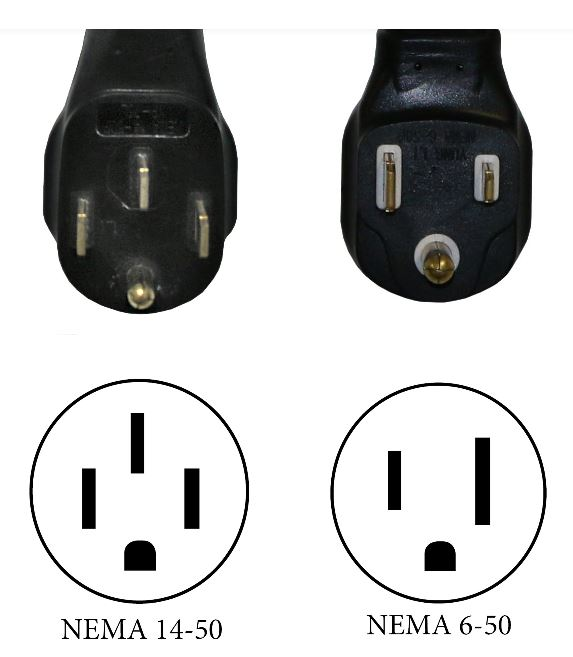
What is the Difference Between NEMA 6-50 and NEMA 14-50?
If you're new to electric vehicles, you may have some questions regarding charging.
Most EV drivers opt for home charging, not only for convenience but also for lower costs.
Ideally, you'd want to invest in a home charging station and a wall connector to reap these benefits. While there are a few different types of plugs available, you'll mostly encounter two types: the NEMA 6-50 and the 14-50.
These plugs are the two ubiquitous ones in the EV world.
Each has its advantage over the other, but the choice will ultimately be based on your needs and preference.
Read on this article to know more about these plug types.
NEMA 6-50 vs. 14-50

As the name suggests, both the NEMA 14-50 and 6-50 outlets can provide up to a maximum of 50 amps of power, which is suitable for charging electric vehicles at home.
The NEMA 14-50 outlet is the more popular and more versatile option of the two, thanks to its wide availability and ability to handle higher power devices.
While the 6-50 outlet may not be as popular as the 14-50, it's starting to compete when it comes to versatility.
Compared to the 14-50, the NEMA 6-50 power cord is easier to install and is more flexible.
The main difference between the two plug types can be seen when you make a side-by-side comparison.
The NEMA 6-50 lacks a neutral wire, so it only has three holes. These holes are the two hots and a ground wire.
Meanwhile, the NEMA 14-50 has four holes: two hots, a ground, and the fourth hole for the neutral wire at the bottom under the two hots.
The plug vs. the EV charging connector
It's easy to get confused with terminologies, but some terms aren't interchangeable.
Case in point, the plug and the electric vehicle charging connector.
The plug connects to your wall outlet, while the EV charging connector plugs into your electric car.
EV chargers hook your EV's battery management and charging system to the electricity flowing through your house.
This means a Level 2 EV charger has to either be hardwired or plugged into a heavy-duty outlet like the one used for electric ovens.
The recommended voltage for an EV's electric supply is 240 volts, while the maximum amperage for safe EV charging is 50 amps.
What is a NEMA 14-50 outlet used for?
The NEMA 14-50 plug is a 240-volt plug with 50 amps of maximum amperage, which is needed for a 40-amp home EV charging station to be safely used. This plug type is commonly found in RV parks and mobile homes.
With the right Level 2 EV charger, electric vehicles can be fully-charged in under 6 hours.
Mobile chargers often have a NEMA 14 50 plug, which means they can be directly plugged into an outlet without the need for hardwired installation.
For safety reasons, only 80% of its maximum power is allowed for continuous use. So, your charger shouldn't produce more than 40 amps when plugged in.
What is a 6-50 plug used for?
Both the 6-50 and 14-50 NEMA plugs are used for appliances that require higher power, like dryers and stoves.
The difference is that NEMA 6-50 outlets are often used for generators and compressors, but have since been used to deliver power to electric vehicles.
The same plug is used by Tesla (with the help of an adapter) to charge its EVs.
This plug type can provide up to 9.6kWh or 30-35 miles of range for your vehicle in just one hour, making it among the fastest plugs for residential chargers.
What are the benefits of using a NEMA 14-50 vs. 6-50?
NEMA 14-50
-
Future proof; upcoming EVs may not have the 6-50 receptacle option anymore
-
More common than the 6-50, so it's easier to find one on the road
NEMA 6-50
-
Cheaper than the 14-50. The extra wire (neutral wire) means additional cost
-
Receptacle outlet is cheaper than the one for 14-50
-
Easier to install because its cable has a smaller cross-section and contains fewer wires, which adds to its flexibility
FAQs
Can you plug NEMA 6-50 into 14-50?
No, the NEMA 6-50 plug does not fit in the 14-50 receptacle.
What is NEMA 14-50 used for?
The NEMA 14-50 plug is commonly used for higher power devices like stoves and dryers.
Is 6-50 or 14-50 better?
Both plug types are safe and powerful. For most EV drivers, the choice boils down to versatility, with the 14-50 being more common nationwide.
Is NEMA 14-50 best for Tesla?
Yes, the 240-volt NEMA 14-50 outlet is the recommended home charging installation for Tesla owners. Make sure to hire a licensed electrician to add a dedicated breaker to your GFCI circuit breaker to accommodate the Tesla Wall Connector. Meanwhile, the Mobile Charger comes with a 14-50 adapter.
How much does it cost to install a NEMA 14-50 outlet?
The cost of installing a NEMA 14-50 outlet ranges between $500 to $2,500. Make sure to hire a qualified electrician to do this.
